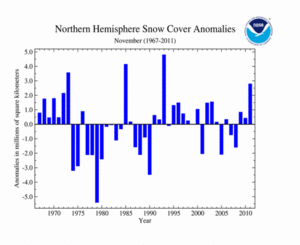NH Snow Cover Extent
Data were provided by the Global Snow Laboratory, Rutgers University. Period of record is 1966-2011 (46 years).
The Northern Hemisphere snow cover extent during November 2011 was much-above average, marking the 4th largest November snow cover extent on record and the third consecutive November with above-average snow cover extent. This is the largest November snow extent since 1993. During the month, the Northern Hemisphere snow cover extent was 36.4 million square km (14.1 million square miles), 2.8 million square km (1.1 million square miles) above the long-term average of 33.6 million square km (13.0 million square miles). The autumn season (September-November) snow cover extent was slightly above average, and ranked as the 15th largest (31st smallest) seasonal snow cover extent in the 46-year period of record.
During November, the North American snow cover extent was above average, ranking as the 13th largest (33rd smallest) November snow cover extent on record. This is the second consecutive November with above-average snow cover for North America, and the largest November snow cover extent since 2003. The monthly snow cover extent was 13.9 million square km (5.4 million square miles), 577,000 square km (222,780 square miles) larger than the long-term average. Several storms impacted the western half of North America, bringing above-average snow cover extent during November to the U.S. and Canadian Rockies and the Canadian prairies. Below-average snow cover was observed from the Canadian Maritimes into the Central U.S. Plains. For the autumn season, North America had near-average snow cover, ranking as the 21st largest (25th smallest) seasonal snow extent on record.
Eurasian snow cover was much-above average in November, and was the 5th largest November snow cover extent for the continent, at 2.2 million square km (849,000 square miles) above average. The November 2011 snow cover extent was the largest extent since 1993. Most of Europe had below-average snow cover extent during the month, as well as Southern China and the Himalayas. Eastern China, most of Mongolia, central China, and western Asia had much-above average snow cover during November. The autumn snow cover extent was also above average for Eurasia, ranking as the 15th largest (31st smallest) autumn snow extent on record.
Sea Ice Extent
According to the National Snow and Ice Data Center (NSIDC), the Northern Hemisphere sea ice extent — which is measured from passive microwave instruments onboard NOAA satellites — averaged for November 2011, was 10.01 million square km ( 3.86 million square miles). The monthly extent was 11.48 percent below the 1979-2000 average and ranked as the third smallest November Northern Hemisphere sea ice extent on record, behind 2006 and 2010. November 2011 is the 18th consecutive November and 126th consecutive month with below-average Arctic sea ice extent. Northern Hemisphere sea ice extent has decreased at an average rate of 4.7 percent per decade. The NSDIC reported that at the end of the month, the ice extent across the Chukchi, Barents, and Kara seas was below average. The Hudson Bay continued to be mostly ice free, which is typically ice covered at the end of November. Near-average ice coverage was observed in the East Greenland and Bering seas.
The November 2011 Southern Hemisphere sea ice extent was 0.53 percent below average — the 11th smallest (23rd largest) extent on record. This is the first November since 2002 with below-average Southern Hemisphere ice extent. This is in contrast to November 2010, when the ice extent reached its largest November value on record. Southern Hemisphere November sea ice has increased at an average rate of 0.6 percent per decade, with significant inter-annual variability.
For further information on the Northern and Southern Hemisphere snow and ice conditions, please visit the NSIDC News page.
 NOAA's National Centers for Environmental Information
NOAA's National Centers for Environmental Information




